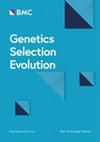Estimating mutation rate and characterising single nucleotide de novo mutations in pigs
IF 3.1
1区 农林科学
Q1 AGRICULTURE, DAIRY & ANIMAL SCIENCE
引用次数: 0
Abstract
Direct estimates of mutation rates in humans have changed our understanding of evolutionary timing and de novo mutations (DNM) have been associated with several developmental disorders in humans. Livestock species, including pigs, can contribute to the study of DNM because of their ideal population structure and routine phenotype collection. In principle, there is the potential for livestock populations to quickly accumulate new genetic variants because of short generation intervals and high selection intensity. However, the impact of DNM on the fitness of individuals is not known and with current genomic selection programs they cannot contribute to estimated breeding values. The aims of our project were to detect and validate single nucleotide DNM in two commercial pig breeding lines, estimate the single nucleotide mutation rate, and characterise DNM. We sequenced (150 bp paired end reads, 30X coverage) 46 pig trios from two commercial lines. Single nucleotide DNM were detected using a trio-aware method. We defined candidate DNM as single nucleotide variants (SNVs) found in heterozygous state in trio-offspring with both trio-parents homozygous for the reference allele. In this study, we estimate a lower threshold of the DNM rate in pigs of 6.3 × 10–9 per site per gamete. Our findings are consistent with those from other mammals and those published for a small number of livestock species. Most DNM we detected were in introns (47%) and intergenic regions (49%). The mutational spectrum in pigs differs from that in humans and we found several DNM predicted to have an effect on animal’s fitness based on the base pair change and their location in the genome. With this study, we have generated fundamental knowledge on mutation rate in a non-primate species and identified DNM that could have an impact on the fitness of individuals.估计突变率和猪单核苷酸从头突变的特征
对人类突变率的直接估计已经改变了我们对进化时间的理解,而新生突变(DNM)与人类的几种发育障碍有关。家畜,包括猪,由于其理想的种群结构和常规的表型收集,可以为DNM的研究做出贡献。原则上,由于短的世代间隔和高的选择强度,牲畜种群有可能迅速积累新的遗传变异。然而,DNM对个体适应度的影响尚不清楚,并且在目前的基因组选择程序中,它们无法对估计的育种价值做出贡献。我们项目的目的是检测和验证两个商品猪育种系的单核苷酸DNM,估计单核苷酸突变率,并表征DNM。我们对来自两条商业品系的46对猪三胞胎进行了测序(150 bp成对端读,30倍覆盖率)。单核苷酸DNM检测采用三感应法。我们将候选DNM定义为在三个后代中发现的杂合状态的单核苷酸变异(SNVs),并且三个父母都为参考等位基因纯合。在这项研究中,我们估计猪的DNM率的较低阈值为6.3 × 10-9每个位点每个配子。我们的发现与其他哺乳动物和少数家畜物种的研究结果一致。我们检测到的大多数DNM位于内含子(47%)和基因间区(49%)。猪的突变谱与人类不同,我们发现一些DNM根据碱基对的变化及其在基因组中的位置预测会对动物的适应性产生影响。通过这项研究,我们对非灵长类物种的突变率有了基本的了解,并确定了可能对个体适应性产生影响的DNM。
本文章由计算机程序翻译,如有差异,请以英文原文为准。
求助全文
约1分钟内获得全文
求助全文
来源期刊

Genetics Selection Evolution
生物-奶制品与动物科学
CiteScore
6.50
自引率
9.80%
发文量
74
审稿时长
1 months
期刊介绍:
Genetics Selection Evolution invites basic, applied and methodological content that will aid the current understanding and the utilization of genetic variability in domestic animal species. Although the focus is on domestic animal species, research on other species is invited if it contributes to the understanding of the use of genetic variability in domestic animals. Genetics Selection Evolution publishes results from all levels of study, from the gene to the quantitative trait, from the individual to the population, the breed or the species. Contributions concerning both the biological approach, from molecular genetics to quantitative genetics, as well as the mathematical approach, from population genetics to statistics, are welcome. Specific areas of interest include but are not limited to: gene and QTL identification, mapping and characterization, analysis of new phenotypes, high-throughput SNP data analysis, functional genomics, cytogenetics, genetic diversity of populations and breeds, genetic evaluation, applied and experimental selection, genomic selection, selection efficiency, and statistical methodology for the genetic analysis of phenotypes with quantitative and mixed inheritance.
 求助内容:
求助内容: 应助结果提醒方式:
应助结果提醒方式:


